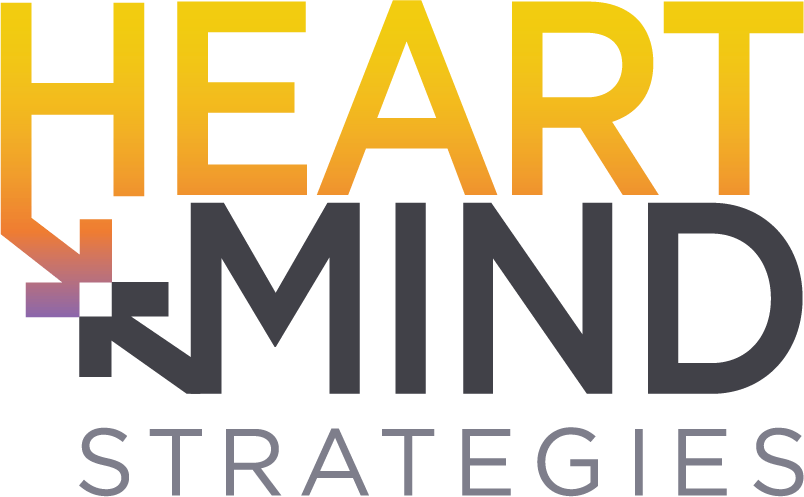By Maury Giles
News flash! We have a communication problem in our country today.
No, it’s not just a partisan divide. Ever since Adams and Jefferson split into parties soon after the formation of our Republic we’ve had serious ideological rancor. Remember duels? Attacking your opponent on the House floor with a cane?
It’s also not centered on a singular issue like the violence that threatened to end our experiment forever through the Civil War because of slavery. There is not a single war to oppose.
Our polarization today is much more widespread though not nearly as deeply rooted. Yet this contemporary risk to our unity seems the greatest we’ve faced because of a simple reality unfolding at alarming speed: We do not speak with or listen to each other. We don’t trust each other. But we want to… right?
Heart+Mind Strategies’ national tracking data shows people today are more concerned and worried than they were during the chaos of the initial months of the pandemic. We feel divided as a nation. We don’t trust our institutions. And we’re also getting more pessimistic (56% today are more pessimistic about the decade ahead — it was only 40% five months ago).
The result is we are skeptical. Tribalism is our go-to coping strategy. And digital and social media facilitate this like never before.
For marketing, as we need to communicate with people to succeed, what does this mean? How do we get across a message that matters? How do we build trust when our media tell us on the hour, practically 24/7, not to trust each other?

Marketing Best Practices
Our experience has shown 6 Marketing Best Practices work in today’s environment:
- Meet people where they are.
- Engage your culture and people.
- Don’t give people a reason not to trust or believe you.
- Lead with safety.
- Champion the human… and deliver on the expectations you set.
- Embrace and live servant leadership traits.
1. Meet People Where They Are
Reaching people is a challenge when people only trust their tribe, even beyond political issues. We are getting used to hearing from and sharing with only those we perceive to be “our people.” Social media algorithms are literally built to facilitate this behavior. Confirmation bias makes it next to impossible to entertain any other source when everything we read seems to validate our opinion, view, or preference.
Fixing the fact this divide exists is better suited for a different thought piece. But recognizing that this is how we behave should trigger a simple thought for the savvy marketer: meet people where they are. Literally talk through and with their tribe.
There is a reason influencer tactics work today. People we believe are in our tribe are replacing institutions as sources of information we can “trust.” Lean into this reality.
This means start by understanding the “tribes” you are trying to reach, what they are built upon or rally around, where they gather, and who they rely upon. Pick the channels they turn to, engage influencers they follow, and be present in the moments that matter to the tribe.

2. Engage Your Culture and People
Another way to lean into tribalism is to own your tribe — your brand. A brand is a shortcut for who and what you are; strong brands also get to “the why”. Your people and culture can and should be the easiest way to show your brand. People recognize tribes. What is yours today?
Your culture should be the cornerstone of your brand. It is what you value, what you believe, and how you show it by what you do. In places where culture leads it is obvious in your approach to people, policies, and promotion. Cotopaxi is a phenomenal current example.
If you have a defined culture you live, use it in your marketing. How does it guide the words you use? What unique ways of connecting grow out of it? What should it feel like to hear from you? Let your culture guide your marketing.
This also means using your people to tell your message. Real people love to hear from real people, the less scripted the better. Trusted surrogates always work well, they’re key in the times we live in today (circling back to our first point). Imagery and examples that tell your story cut through the clutter when true to your culture.
3. Don’t Give People A Reason Not to Believe
Skeptical people feed off stories that validate their perspective. Brands play into this when you do or say something that proves to be either inauthentic, not real, or not true.
This point is not about being ethical. Hopefully, that is obvious already.
This means being true to who you are and what you offer. It is about being real and not something you are not.
Most people want to trust you and to believe in you. Candid openness and genuine vulnerability surprise and delight people in today’s environment. They have come to not expect it. When we find it, it taps into our intrinsic desire to reciprocate kindness when offered literally without strings attached.
4. Lead With Safety
Most of us do not enjoy the disappearance of civility in daily interactions. While we may engage, experiencing what it feels like is not fun beyond the temporary sense of defining or defending my tribe. We want and deserve more.
Create and communicate a culture of safety. Make it real. It starts with literally being safe physically. But owning this can mean so much more. Respect. Openness. Welcoming.
Stand for something while honoring the freedom of others to do so as well.
5. Champion the Human
Expectations matter when it comes to being authentic in communications. Delivering on meaningful needs or wants pays huge dividends when what you say is obviously delivering what the people you are talking to really want.
Think about reading a blog post like this that catches your attention. Or, better yet, consider an online webinar you have attended. How many times have you seen a title that seemed perfect for your need? You get there only to discover it’s something totally different. A sales pitch. A demo.
Not fun. A frustrating waste of time. Irritating. It is set up as something that is primarily, if not only, meeting the interest and need of the host, not the participant.
Flip that approach, on purpose. Filter what you plan to communicate through real human needs you can and will address. Don’t be afraid of consumer choice, embrace it.
What is the hidden gem you can help someone find? What will surprise and delight? What do they need that you offer, and they can’t find anywhere else? Stay focused on simple answers to these questions and tell them through the human lens of your audience.
People know and see when you present your case clearly with a genuine intent to serve and meet their needs. In a time when cynicism is high, championing the human stands out for all the right reasons.
6. Embrace and Live Servant Leadership Traits
Political communication is a good source of inspiration for marketing in a fake news environment. You could argue political campaigns operate in this context much of the time. Tribalism. Untruths. Scare tactics. Manipulation.
But the lasting “brands” in the political world, those who we remember for having driven change for good, are those who inspire through servant leadership. This is what we want when safety and family are concerned. We want something in which we can believe to free us to do and be what and who we want.
Over years of working on campaigns local, national, and international, Richard B. Wirthlin taught what he saw as a consistent pattern in these leaders – the “communicators.” In fact, he saw it in his highest profile client, the Great Communicator, Ronald Reagan.
Effective leadership through communications operates across these dimensions: honest and trustworthy, strong and consistent, has a vision, can make the vision a reality/get things done, shared concerns, shared values, and cares about people like me.
Turn to these traits when you truly want to know how to be open, transparent, timely, and relevant in what you say and what you do. Which are you the best at today? How and why do they matter to the people you need to reach? What best demonstrates each?
People will respond when you filter the way you communicate through these traits.

What About Taking a Stand in Today’s Polarized Market?
Today’s tribalism dynamic leads many to believe brands must pick their tribes and take a stand on issues of the day. We would say this is true in some ways, but false in others. It is not what we mean when we say lean into the tribe. At least not exactly.
Every brand, organization, or corporation does not need to take a public stand to be trusted and credible in a polarized time. When it is true to what you stand for, when it matters to the people most important to your success, when your conviction for societal change is real–these are the times when joining or leading a tribe on a polarized issue might make sense.
It is likely to matter most and make the most sense first for internal stakeholders. Your people may need to know you have shared values and care about them. Listen. Be clear. Make real decisions that result in meaningful behavior changes or actions.
Externally, however, the bar should be higher for when it becomes part of your public relations or marketing agenda.
Consider Ben & Jerry’s. How many brands can take a stand that they will not serve their product in a part of the world where they disagree with political practices… and get away with it? By get away with it we mean it feels natural and not weird. The stance they took is so true to their brand that we’re hearing now about their board leading a suit against their parent company, Unilever, who recently ended it. They don’t agree with the demands Unilever made and they’re standing up for the right to express their mission in the world.
Not many brands are built like Ben & Jerry’s. They literally started from day one with a mission and purpose that had a societal play. They’ve been true to it inside and out. It is who they are.
Yet we’re seeing many brands today feel they have to make a public stand on one or many of the major issues of our time. Abortion. Climate change. Racial discrimination. Gun control. Sexism. Gender identity.
There are two problems that should give marketers pause before jumping all-in with a public stance:
- First, their customers likely belong to different tribes, tribes who have passionate views on opposite sides of the issue.
- Second, the tides turn on the topic du jour, which means any stance must be anchored in conviction or risk fueling distrust in the long run.
The answer for this one is quite simple. Engage in an issue publicly when you intend to make a difference. Is it a real part of your mission, purpose, and vision? Are you poised to participate in the issue? Do you have a solution that addresses relevant human needs?
In Summary: Make It Real
Yes, marketing planning is trickier today than ever before. Yet the axiom of simplicity matters still applies. Be real.
Consider these marketing best practices when planning how to market in today’s “fake news” environment:
- Meet people where they are.
- Engage your culture and people.
- Don’t give people a reason not to trust or believe you.
- Lead with safety.
- Champion the human… and deliver on the expectations you set.
- Embrace and live servant leadership traits.
